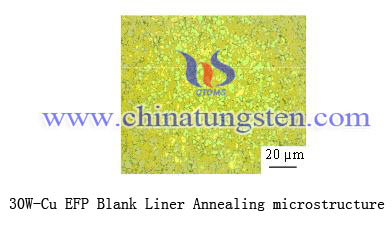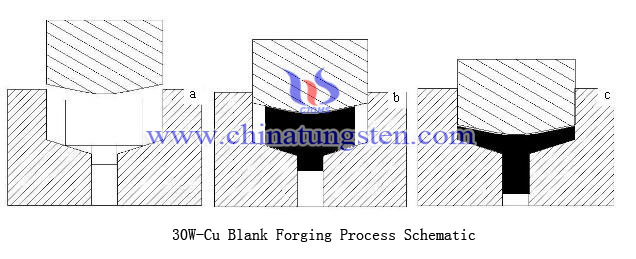Tungsten Copper EFP Liner Preparation
Forging can significantly improve material densification. Ordinary tungsten copper rod produced malleable significantly better than the bar ultrafine tungsten-copper composite powders prepared. Using bar malleable poor ultrafine tungsten-copper composite powder preparation, the use of tungsten-copper composite powder particle size is relatively small, the size between 100 ~ 300 nm, the surface of the active particles is very large, complex powder easily oxidized and absorbent composite powder impurities more material nor vacuum treatment after sintering, and therefore a higher hydrogen content in the material, it is easy to cause hydrogen embrittlement. You can take some measures to reduce the impact of these negative factors for material properties, but the material finally produced can not meet the requirements of low cost, subsequent forging test uses ordinary tungsten copper rod produced.
The following figure shows the process of forging 30W-Cu EFP liners rough schematic. Before forging rough density of 9.79 g.cm-3, up 91.6% theoretical density, elongation of 5.5%, the material is brittle state. The resulting estimate the amount of deformation according to the thickness of the tapered portion blank before and after deformation, deformation reaches 72%.
In the blank forging process, blank deformation undergone three stages: the first stage is an upsetting blank die in the process, in this process, the upper and lower portions of the blank is first deformed, the upper part of the role of stress and lower gradually become less porous, density, and the die and punch of the contact area increases, friction increases, the friction produces a tensile stress component under the action of the metal tensile stress produces lateral flow , as shown in Figure 7b. In the second stage, the metal cross flow is hindered, the metal will flow along the hole at the bottom of the female mold, in the process to further reduce the blank within the pores, the density increases continues. It reached the first three stages of deformation when the flow to the ejector rod: multi-pressure stage, rough primarily through hydrostatic pressure to eliminate pores, to achieve the complete elimination of micropores is very difficult, so at this stage is limited density of the blank, blank densification process to improve the main Phase 1 and 2, the rational design of liners rough shape, control the quality of rough, so rough in Phase 1 and 2 is sufficiently deformed, eventually increasing the density of the blank after forging.
Tungsten copper blank forging process, the deformation of the matrix material, there are two ways. The first one is just a copper substrate deformation, deformation of tungsten particles does not occur, and the tungsten particles flow along the deformation direction of the base, and finally was streamlined distribution in the matrix. The second way is the copper substrate and the tungsten particles are deformed, copper and tungsten were tested after deformation fibrous. After forging the blank is then annealed microstructure was observed annealing temperature of 500 ° C, time 2 h. below is 30W-Cu EFP liners blank after forging through 500 ° C, 2 h annealing microstructure.
As can be seen from the figure, the copper matrix recrystallization occurs, to form a uniform fine grain structure, tungsten particles are substantially not occur grow and segregation. Fibrous tungsten and not deformed in the forging, heat treatment because of the lower temperature, and recrystallization temperature of tungsten is much higher than the annealing temperature, if the tungsten particles are deformed, then annealed at this temperature after the tungsten particles will remain deformed when organization, which is inconsistent with the experimental observation. Therefore, the deformation mode of tungsten copper blanks belongs to the first mode, metallographic not observed streamline the distribution of the tungsten particles is in the process of forging the metal in the longitudinal and circumferential directions have taken place in the flow of sake.

Final Conclusion:
It can significantly increase the density of tungsten-copper sintered materials by forging, annealing after forging 30W-Cu EFP Liner material density up to 98.2% of the theoretical density. After the heat treatment the tensile strength of the material reaches 315 MPa, elongation rate was 15.3%.
Any feedback or inquiry of Tungsten Copper Alloy Products please feel free to contact us:
Email: sales@chinatungsten.com
Tel.: +86 592 512 9696 ; +86 592 512 9595

